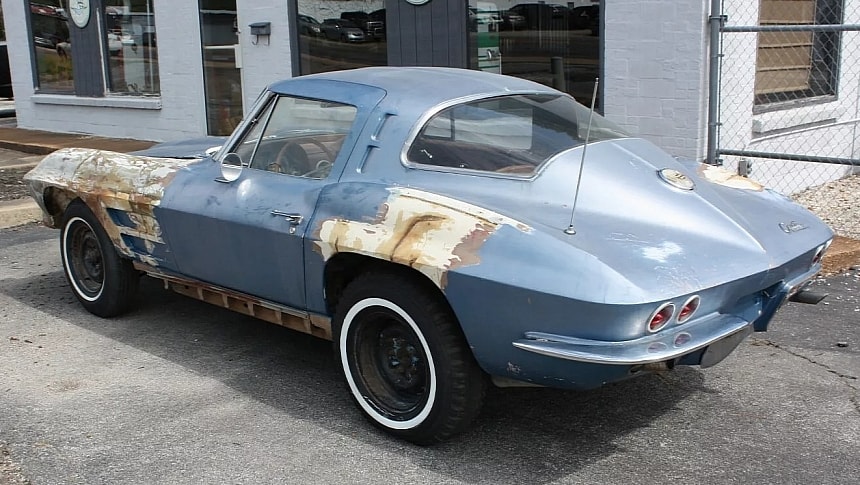Launched in 1953, the first-generation Corvette remained in production for a whopping nine years. However, enthusiasts got a taste of the C2 a few good years before it arrived in showrooms. In 1959, Chevrolet unveiled the Sting Ray concept as a preview. It was followed by the XP-700 in 1960 and the Mako Shark in 1962. The second-gen Corvette debuted for the 1963 model year.
And surprisingly enough, it retained many of the spectacular features showcased in the concept cars. Sleek, stylish, and available with up to 360 horsepower thanks to fuel injection, the 1963 Corvette became an instant hit. Sales increased by a whopping 50%. However, not all styling cues were embraced by the public.
The two-piece rear window proved troublesome due to safety and visibility issues. Chevrolet acted accordingly and replaced it with a one-piece unit in 1964. Thus, the split window became a one-year-only feature. Moreover, many owners opted to eliminate the central divider and install single-piece windows once they became available.
But as the years went by, the split-window Corvette morphed into a collector's item. Come 2024, the 1963 Corvette coupe is a six-figure classic, and certain options (like the Z06 package and fuel injection) will put a $300,000+ sticker on a highly original example. But it seems derelict units are also becoming increasingly more expensive, even when the sought-after split rear window is missing.
The blue example you see here is one of those rigs that was retired after only a few years on the road. Parked in 1968, it remained in storage for a whopping 56 years. Naturally, rust wasn't an issue for the fiberglass body, but the Corvette is more of a project car than an oldtimer you can put back on the road with minor repairs.
Originally finished in Saddle Tan with a matching interior, the coupe was repainted light blue before it was parked for good. When that happened, the owner also opted to replace the split rear window with a single-piece unit. The car also lost its original hood in favor of a 1965 lid.
The interior is in far better condition than the exterior, but the engine bay is empty. And there's good news and bad news in this department. The good news is that the original 327-cubic-inch (5.4-liter) V8 block still exists. The bad news is the mill is pretty much a puzzle with no info on which other components are still original.
All told, it's a restoration project that will require extensive documentation and the acquisition of several components—the kind that will probably cost $100,000. But that didn't stop enthusiasts from bidding more than $40,000 to take it home. As of this writing, 36 bids have pushed the sticker to $45,100. And get this: the reserve is still in place.
Sure, I get that it still has a numbers-matching engine and that the 340-horsepower L76 engine makes it one of fewer than 3,500 units built, but it feels a tad pricey for a Corvette in this condition. What do you think? Let me know in the comments section below.
The two-piece rear window proved troublesome due to safety and visibility issues. Chevrolet acted accordingly and replaced it with a one-piece unit in 1964. Thus, the split window became a one-year-only feature. Moreover, many owners opted to eliminate the central divider and install single-piece windows once they became available.
But as the years went by, the split-window Corvette morphed into a collector's item. Come 2024, the 1963 Corvette coupe is a six-figure classic, and certain options (like the Z06 package and fuel injection) will put a $300,000+ sticker on a highly original example. But it seems derelict units are also becoming increasingly more expensive, even when the sought-after split rear window is missing.
The blue example you see here is one of those rigs that was retired after only a few years on the road. Parked in 1968, it remained in storage for a whopping 56 years. Naturally, rust wasn't an issue for the fiberglass body, but the Corvette is more of a project car than an oldtimer you can put back on the road with minor repairs.
Originally finished in Saddle Tan with a matching interior, the coupe was repainted light blue before it was parked for good. When that happened, the owner also opted to replace the split rear window with a single-piece unit. The car also lost its original hood in favor of a 1965 lid.
The interior is in far better condition than the exterior, but the engine bay is empty. And there's good news and bad news in this department. The good news is that the original 327-cubic-inch (5.4-liter) V8 block still exists. The bad news is the mill is pretty much a puzzle with no info on which other components are still original.
All told, it's a restoration project that will require extensive documentation and the acquisition of several components—the kind that will probably cost $100,000. But that didn't stop enthusiasts from bidding more than $40,000 to take it home. As of this writing, 36 bids have pushed the sticker to $45,100. And get this: the reserve is still in place.
Sure, I get that it still has a numbers-matching engine and that the 340-horsepower L76 engine makes it one of fewer than 3,500 units built, but it feels a tad pricey for a Corvette in this condition. What do you think? Let me know in the comments section below.

